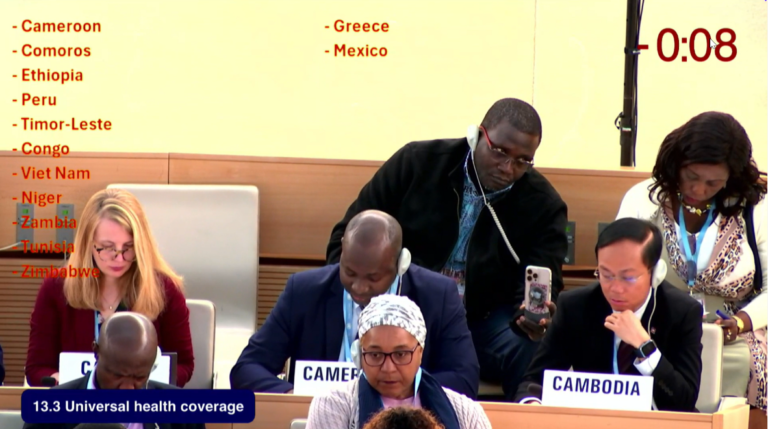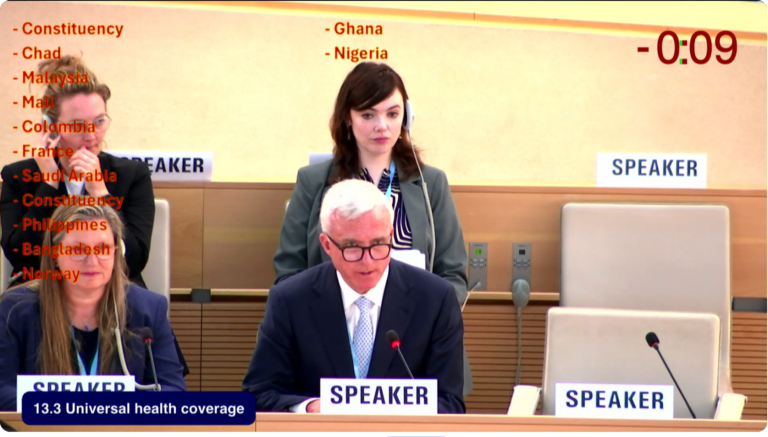WHA RESOLUTION


Cancer and other non-communicable diseases (NCDs) are rising and disproportionately affecting low- and middle-income countries (LMICs), yet access to medical imaging remains severely limited. The Resolution on Strengthening Medical Imaging Capacity seeks to address this gap by strengthening medical imaging capacity in all countries, leading to improved patient outcomes.
It builds on the WHA76.5 Resolution on Strengthening Diagnostics Capacity approved in 2023 and is based on The Lancet Oncology Commission on Medical Imaging and Nuclear Medicine, The Lancet Oncology Commission on Cancer in Sub-Saharan Africa and The Lancet Oncology Commission on Radiotherapy and Theranostics, which demonstrated the health and economic benefits of improving access to medical imaging and nuclear medicine for cancer.
The resolution will guide the joint efforts to strengthen medical imaging capacity and access worldwide.
Our sincere gratitude goes to Cameroon and the co-sponsoring countries, the WHO Executive Board, who recommended the Resolution during its session in February 2025, all Non-State Actors who supported the WFNMB-ISR led constituency statement and the WHO member states who ratified the resolution during the World Health Assembly.
The imaging professionals and medical technology community stand ready to support the implementation of the resolution. We look forward to continuing our work with NSAs and other professional societies, UN agencies and industry in driving future progress in this area.
The recording of the WHA 2025 sessions including the reading of the Constituency Statement and the ratification of the Resolution on Strengthening Medical Imaging Capacity can be watched on the right sidebar on the WHO webpage here:

Reading of the Constituency Statement: see
WHA 78 – Committee A
Tenth Committee A meeting
24/05/2025 – 09:10-13:15 – see 38:46
Reading of Cameroon’s statement:
Watch the WHO recording on our YouTube channel below
Ratification of the Resolution on Strengthening Medical Imaging Capacity:
Watch the WHO recording on our YouTube channel below
Archive - May 2025
May 2025 – Cancer and other non-communicable diseases (NCDs) are rising and disproportionately affecting low- and middle-income countries (LMICs), yet access to medical imaging remains severely limited. The proposed resolution seeks to address this gap by strengthening medical imaging capacity in all countries, leading to improved patient outcomes.
Imaging is essential across the cancer care continuum—from diagnosis to treatment planning and follow-up—as well as for radiotherapy, interventional radiology, and theranostics. It is also vital in managing injuries, other NCDs, and infectious diseases, including many of the world’s leading causes of mortality.
Ensuring equitable, sustainable access to medical imaging, including nuclear medicine, is imperative to improving health outcomes globally.
Following the adoption of the resolution by the WHO Executive Board on February 10, the Resolution is now on the WHA78 agenda for ratification.
The World Federation of Nuclear Medicine and Biology (WFNMB) and the International Society of Radiology (ISR) have again coordinated a constituency statement in support of the proposed resolution. The full statement can be accessed here. We sincerely thank the following Non-State Actors in official relations with the WHO for their support:
- World Federation of Nuclear Medicine and Biology (WFNMB)
- International Society of Radiology (ISR)
- Global Diagnostic Imaging Healthcare IT and Radiation Therapy Trade Association (DITTA)
- Health Technology Assessment International (HTAi)
- International Federation on Ageing (IFA)
- International Federation of Healthcare Engineering (IFHE)
- International Federation for Medical and Biological Engineering (IFMBE)
- The International Federation of Surgical Colleges and Societies (IFSCS Ltd)
- International Organization for Medical Physics (IOMP)
- International Society of Radiographers and Radiological Technologists (ISRRT)
- Humatem
- Multiple Sclerosis International Federation (MSIF)
- NCD Alliance
- The International Society of Paediatric Oncology (SIOP)
- Thalassaemia International Federation (TIF)
- World Federation for Ultrasound in Medicine and Biology (WFUMB)
If adopted by the World Health Assembly 2025, the resolution is expected to have a major impact not only in low—and middle-income countries but also globally in addressing the rising burden of cancer and other non-communicable diseases.
The WHA sessions can be watched live on 19–27 May 2025 here:
https://www.who.int/about/governance/world-health-assembly/seventy-eighth
Recordings will be available on the above webpage.
Archive - February 2025
February 2025 – It is our pleasure to announce that a resolution on Strengthening medical imaging capacity has been adopted by the WHO Executive Board during its session on February 10, for submission to the World Health Assembly (WHA78) to be held in Geneva from May 19-27, 2025.
The resolution addresses the rising burden of cancer and other non-communicable diseases. It was led by Cameroon, co-sponsored by Armenia, Brazil and Burkina Faso and garnered strong consensus support from multiple Member States, including China and Thailand during the WHO Executive Board session.
The World Federation of Nuclear Medicine and Biology (WFNMB) and the International Society of Radiology (ISR) coordinated a constituency statement in support of the proposed resolution. The following Non-State Actors in official relations with the WHO supported the constituency statement:
- WFNMB (World Federation of Nuclear Medicine and Biology)
- ISR (International Society of Radiology)
- DITTA (Global Diagnostic Imaging Healthcare IT and Radiation Therapy Trade Association)
- Humatem
- IAPO (International Alliance of Patients’ Organizations)
- IFA (International Federation on Ageing)
- IFMBE (International Federation for Medical and Biological Engineering)
- IFSC Ltd. (International Federation of Surgical Colleges)
- IOMP (International Organization of Medical Physics)
- ISQua (The International Society for Quality in Health Care Company Limited by Guarantee)
- ISRRT (The International Society of Radiographers and Radiological Technologists)
- MSIF (MS International Federation)
- RAD-AID International
- SIOP (The International Society of Paediatric Oncology)
- TIF (Thalassaemia International Federation)
- WFUMB (World Federation for Ultrasound in Medicine and Biology)
- WMA (World Medical Association)
- WSO (World Stroke Organization)
The statement was read during the WHO Executive Board session on February 5. The abbreviated version is available on the WHO EB webpage (See pillar 1). The full constituency statement can be accessed here.
The recordings of the 156th session of the WHO Executive Board including the presentation of the Constituency Statement (see EB156, Session 5, 05/02/2025 – 10:05-13:00, min. 11:00) and the adoption of the resolution for submission to WHA 78 (see EB156, Session 18, 10/02/2025 – 18:55-19:40 – min 11:00) can be watched here.
If adopted by the World Health Assembly 2025, the resolution is expected to have a major impact not only in low—and middle-income countries but also globally in addressing the rising burden of cancer and other non-communicable diseases.